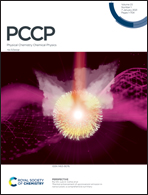ESIPT fluorophores derived from 2,3-dichloro-5,6-dicyano-p-benzoquinone based carbon dots for dual emission and multiple anti-counterfeiting†
Abstract
Fluorophores and hydrogen bonding interactions play key roles in the fluorescence properties of bottom-up carbon dots. In this work, an excited-state intramolecular proton-transfer (ESIPT) active fluorophore, 5-chloro-6-ethoxy-4,7-dihydroxyisoindoline-1,3-dione (CEDD) and a non-ESIPT 7-cyano-5,8-dihydroxyquinoxaline-6-carboxamide (CDQC) are extracted from 2,3-dichloro-5,6-dicyano-p-benzoquinone (DDQ) based carbon dots. The enol form of CEDD shows a weak blue, small Stokes shift and short lifetime emission under the aprotic or alkali conditions, but the keto form exhibits a strong green, large Stokes shift and long lifetime emission in a protic or an acidic environment. Due to the lack of the ESIPT process, CDQC has no dual emission characteristics, but shows efficient solid-state emission. By virtue of the ESIPT ability of CEDD, multiple anti-counterfeiting methods are achieved by using hydrogen chloride, ammonia, and fluorescence lifetime imaging, as well as dimethyl sulfoxide as the encryption/decryption tools.



 Please wait while we load your content...
Please wait while we load your content...